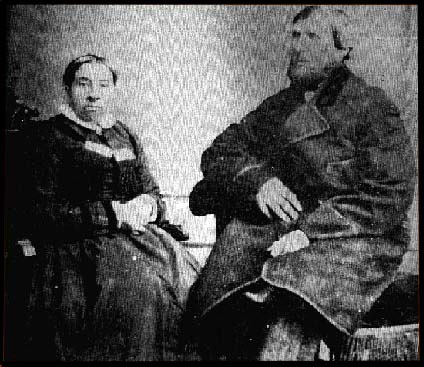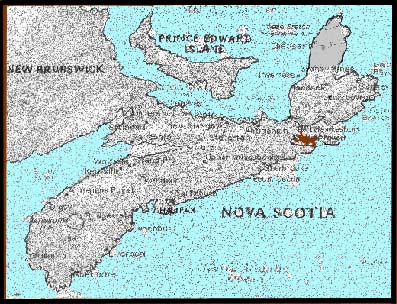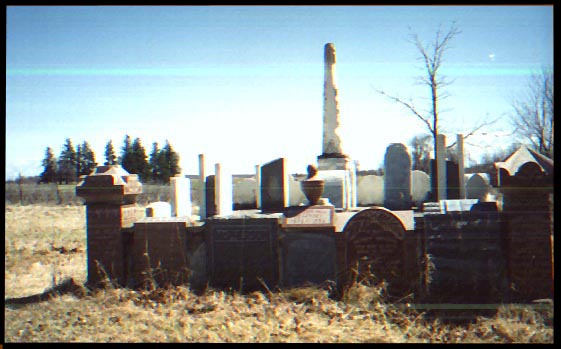
Descendants of James McPherson 1790 - 1878
and Ann Catherine Whitman 1799 - 1880
The family believes the above photo is of James and Ann Catherine.
James McPherson was my Great-Great Grandfather -- a farmer, a cabinet maker, carpenter and ship wright. James was born December 19, 1790 in Guysborough, Nova Scotia.
Guysgorough is located West of Canso and South East of Antigonish. Next door to the town is  Manchester,
Nova Scotia. The earliest homesteaders in both settlements were the disbanded soldiers of the defeated British army after the Revolutionary War, and the New England United Empire Loyalists. Both groups chose to start fresh under the Union Jack in the wilderness of Nova Scotia.
Manchester,
Nova Scotia. The earliest homesteaders in both settlements were the disbanded soldiers of the defeated British army after the Revolutionary War, and the New England United Empire Loyalists. Both groups chose to start fresh under the Union Jack in the wilderness of Nova Scotia.
Jim met Ann Catherine Whitman while working in a shipyard in Manchester owned by her father, George Whitman. Ann and Jim married March 26, 1816 in Guysborough. In the following thirty years they had 14 children. 12 survived to adulthood.
There was a significant movement of the second generation of UEL's from the maritimes and Lower Canada (Quebec) to the west. In those days, the Huron Tract along the shores of Lake Huron was "Canada West" and homesteads could be bought from the
Canada Company. That may have been the reason why Jim and Ann and all of their surviving children, children's spouses and grandchildren made the decision to sell up and move to Ontario.
The route taken from Nova Scotia was probably through the province of New Brunswick, the upper part of Maine and stopping at Stanstead where they had neices, nephews and cousins.
They also stayed for a time in Boston. The McPherson sisters, MARY (Marianne)and Selina had married two Wilson brothers. In Boston there were two more Wilson brothers. The Boston /Greenway association remained so strong for a generation that a general store built at the cross roads at Greenway was named "Boston House" and run by a Wilson. On some old maps Greenway appears as "Boston".
After leaving their relations, the "tribe" of McPhersons decided to continue north-west almost certainly travelling now by Ox Carts. They were ferried across the Lake Champlain to near Fort Blunder, and then in a northerly direction to Beauharnais. They used the Cornwall Canal to get around the rapids at Long Sault. Eventually they reached the stop over of Reach Township, Ontario.
In this location they purchased the lots in the Huron Tract from the Canada Company and set out to homestead by clearing and building the minimum necessary to prevent forfeit of their purchase. The fact that there were so many capable hands to work together in this task definitely gave them an edge over some of their neighbours. It is on record that a few settlers simply gave up and walked away after the first winter (or during the first winter).
"After travelling from Reach, they stopped in an area known as Spidertown, where a small encampment was made and a fire built for warmth, cooking and to scare away any unwanted animals. A make shift shelter was made in the shelter of some giant pine trees. The trees caught fire and they had to be content with the shelter of their wagons and possibly in the dense bush. They finally reached the destination of available lands along the south boundary of Huron and the North boundary of McGillivray Township. Lots of 100 acres were chosen." -- material provided by the notes of Donald MacPherson.
One mile west of the present village of Greenway, Ontario was founded the McPherson settlement in the fall of 1852. It was then that James McPherson with his family and the families of his two sons in law, James and John Wilson arrived from Nova Scotia acquiring 100 acre lots of unbroken bush.
They built shanties and cleared the land. They cut grain with a scythe and threshed it with a flail after binding it by hand. They then toted it on their backs to the nearest mill in Parkhill. Ireland or Irishtown (Near Clandeboye)
was the nearest store and supplies were brought from there. The money for this was procured by splitting shingles by hand and by making maple syrup.
--
London Free Press article by S Armitage Stanley (date unknown) found in the scrapbook of Margaret Clarissa McPherson Luther.
A unique look at the McPherson Settlement was provided by Jim and Ann's great- grand- daughter, Mae Wilson in the Parkhill Gazette, Thursday February 7 1924 from a contest entitled "Pioneer Days".....
In the fall of 1852, James McPherson, his wife and their families came here from Nova Scotia. They settled one mile west of Greenway: James McPherson and John Wilson each taking 100 acres in McGillivray Twp. and James Wilson and Rufus McPherson (known as Uncle Rufus) taking 100 acres in Stephen.
Land was three dollars an acre and at the end of ten years was valued at ten dollars. At that time they received the deed to their land which was written on parchment. The land was all unbroken forest and had no roads.
For a short time they had to go to Clandeboye to buy supplies, but soon after a Mr. Brewster built a mill and a store at Grand Bend. Many times they walked carrying their produce to Brewster's, a distance of six miles, and bringing back their groceries. Some years later a store was opened at Pine Hill (south of Thedford) and they often went there for supplies.
The only means they had of obtaining money was by making shingles by hand for which they received two dollars per thousand. As soon as they woke up, they got up and worked until dark felling trees.
The fall that they came they often saw deer, bears and wild cats and the tracks of wolves. One day in the winter, James McPherson and Thomas Marks walked to Brewster, when on the back of Rufus' farm they saw tracks made by two bears. James hurried home for his gun and to get help to follow the bears, but none of the men were home. He followed the tracks for a long time and
finally located both bears in a tree within a short distance of his home. He called for help and all the women and children came to his assistance. Ann Hutchinson and Selina Wilson were carrying burning sticks to help in the rescue.
James decided that it was too late to do anything that night and Selina built a fire near the tree and kept watch all night while Grandmother McPherson (Ann Whitman) took care of the children. At daybreak, Bill McPherson, a young lad at the time) was dispatched to the Mark's settlement to get another gun, but came back empty handed, and before he returned some indians led
by "Cut-Nose" appeared. They had been trailing the bears and had camped when night fell. Cut-Nose suggested cutting down the tree, which was hollow, and by that time contained both the bears. Before the tree hit the ground, Cut-Nose was on it and when a bear poked an inquisitive nose out of the opening, he was shot. Then they cut holes in the tree and fired seven shots
killing the second bear. James offered Cut-Nose the smaller bear for his share, which he gladly accepted, and in a short time the Indians had peeled Basswood bark from the trees and were off.

Ann and James died in McGillivray Township and were buried in the Meadowhill Cemetery just north of Parkhill. The stones have been gathered into a Cairn. Some of their descendants are still in the area of the old homesteads, others have spread out all over North America.
The history of each of the 14 children can be found by clicking on the links below.
i. MARIANNE (MARY) MCPHERSON
ii. CLARISSA MCPHERSON
iii.
ISABELLE MCPHERSON (died in infancy)
iv.
MARGARET MCPHERSON
v. SELINA ELIZA MCPHERSON
vi. CATHERINE
ISABELLEMCPHERSON
vii. RUFUS
WHITMAN MCPHERSON
viii.JANE MCPHERSON (died in infancy)
ix. CHRISTIAN (CHRISTI - ANN) (ANN) MCPHERSON
x. GEORGE
MCPHERSON
xi. ESTHER
MCPHERSON
xii. JAMES WILLIAM "BILL" MCPHERSON
xiii. CHRISTIAN "CHRISTOPHER" FREDERICK MCPHERSON
xiv. SARAH JANE MCPHERSON
In the company of their closest kin were Edmund and David McPherson
i. Edmund McPherson
ii. David McPherson
HOME
 Manchester,
Nova Scotia. The earliest homesteaders in both settlements were the disbanded soldiers of the defeated British army after the Revolutionary War, and the New England United Empire Loyalists. Both groups chose to start fresh under the Union Jack in the wilderness of Nova Scotia.
Manchester,
Nova Scotia. The earliest homesteaders in both settlements were the disbanded soldiers of the defeated British army after the Revolutionary War, and the New England United Empire Loyalists. Both groups chose to start fresh under the Union Jack in the wilderness of Nova Scotia.

